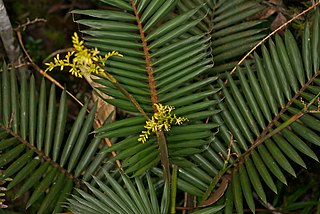
Areca is a genus of 51 species of palms in the family Arecaceae, found in humid tropical forests from the islands of the Philippines, Malaysia and India, across Southeast Asia to Melanesia. The generic name Areca is derived from a name used locally on the Malabar Coast of India.

Calamus is a genus of flowering plants in the palm family Arecaceae that are among several genera known as rattan palms. There are an estimated 400 species in this genus, all native to tropical and subtropical Asia, Africa, and Australia.

Daemonorops was a genus of rattan palms in the family Arecaceae. Its species are now included within the genus Calamus.

Licuala is a genus of palms, in the tribe Trachycarpeae, commonly found in tropical forests of southern China, Southeast Asia, the Himalayas, New Guinea and the western Pacific Ocean islands.
Dypsis basilonga is a species of flowering plant in the family Arecaceae. It is endemic to Madagascar. It grows in humid, mossy habitat on mountains. It is threatened by overharvesting.

Dypsis crinita is a species of flowering plant in the family Arecaceae. It is found only in Madagascar. It is threatened by habitat loss.
Dypsis lanceolata is a species of flowering plant in the family Arecaceae. It is found only in Comoros.
Dypsis mananjarensis is a species of flowering plant in the family Arecaceae. It is found only in Madagascar. It is threatened by habitat loss.
Dypsis nauseosa is a species of flowering plant in the family Arecaceae. It is found only in Madagascar. It is threatened by habitat loss.

Dypsis pembana is a species of flowering plant in the family Arecaceae. It is found only in Tanzania.
Dypsis rivularis is a species of flowering plant in the Arecaceae family. It is palm endemic to Madagascar, where it grows in forests near rivers. It is threatened by habitat loss. There are fewer than 100 mature individuals estimated to remain.
Dypsis sahanofensis is a species of flowering plant in the family Arecaceae. It is found only in Madagascar. It is threatened by habitat loss.
Orania trispatha is a species of flowering plant in the family Arecaceae. It is found only in Madagascar. It is threatened by habitat loss.

Pinanga is a genus of flowering plant of the palm family in the subtribe Arecinae. It is native to eastern and southern Asia across to New Guinea.
Satranala decussilvae is a species of flowering plant in the Arecaceae family. It is a palm endemic to Madagascar. It is the only species in the genus Satranala, and is threatened by habitat loss. There are perhaps 200 mature individuals remaining.
Wettinia is a palm genus, consisting of flowering plants in the family Arecaceae. The genus, established in 1837, contains some 20 species, but more seem to await discovery considering that 4 species - W. aequatorialis, W. lanata, W. minima and W. panamensis - were described as late as 1995. The genus is broadly divided into two groups. One group has the fruits tightly packed, while the other, formerly classified as genus Catoblastus, has fruits scattered along the inflorescence branches. It is not known whether these groups are both monophyletic. The genus is named after Frederick Augustus II of Saxony, of the House of Wettin.

Orania is a genus of the palm tree family Arecaceae, and includes flowering plants native to Southeast Asia, Madagascar, and New Guinea.
Maxburretia is a genus of three rare species of palms found in southern Thailand and Peninsular Malaysia. The genus is named in honor of Max Burret, a German botanist.

Korthalsia is a clustering genus of flowering plant in the palm family spread throughout Southeast Asia. It is a highly specialized rattan with some species known to have an intimate relationship with ants, hence the common name ant rattan. High-climbing and armed with spines, the genus is named for the Dutch botanist P. W. Korthals who first collected them from Indonesia.









